Study of the human genome, proteome, and pharmaceutical testing require electrowetting on dielectric (EWOD) devices to create, move, split, and mix confined droplets of fluid with volumes on the order of 40 – 500 nL. The manipulation of droplets with electric fields allows these devices to operate without channels, pumps, or valves. These devices overcome the disadvantages of channel based systems while preserving their advantages by leveraging the physical phenomena that are dominant on the microscale instead of working against them. The ultimate goal of this research project is the development of microfluidic EWOD devices that can perform as practical biological protocols.
Throughput demands on the tools used in the study of the human genome, proteome, and pharmaceutical testing are increasing exponentially. Despite giving excellent results, the protocols traditionally used in these pursuits have relatively long cycle times due to inefficient mass transport of biological material from solution to the reaction site. Cycle times can be reduced by increasing reagent concentrations, but this results in the overuse of expensive reagents. These disadvantages are particularly limiting in proteomics, where reagents cannot be easily synthesized.
A micro total analysis system (μ-TAS) automates a macroscale process by integrating a series of modules onto a single microscale device. In many applications, the development of these systems increases efficiency and throughput by reducing cycle times and the consumption of raw materials. Most μ-TASs for biological applications are based on continuous flow microfluidics. Although these systems have reduced cycle times and raw material consumption, they are difficult to fabricate due to the need for complex components like valves and they make use of external pumping to overcome the large pressure drops associated with small channels. More recently, droplet based microfluidic devices have been introduced as tools to increase throughput and reduce operating costs of biological protocols.
Electrowetting on dielectric (EWOD) devices are novel μ-TASs that apply asymmetric electric fields to create (Figure-1), move, split, and mix confined droplets of fluid with volumes on the order of 40 – 500 nL (Figure-2). The manipulation of droplets with electric fields allows these devices to operate without channels, pumps, or valves. These devices overcome the disadvantages of channel based systems while preserving their advantages by leveraging the physical phenomena that are dominant on the microscale instead of working against them.
https://www.youtube.com/watch?v=1_6outfjTtY
Figure-1. Narrated presentation of the fundamental and practical contributions to digital microfluidic devices made through the EWOD project.
https://www.youtube.com/watch?v=AeGys0Naz8s
Figure-2. Creation and manipulation of 2 mm diameter droplets using EWOD. During manipulation, the droplet switching frequency is 10 Hz which results in an average droplet velocity of over 2 cm/s.
In an EWOD device, the application of an asymmetric electric field on a droplet creates an asymmetric deformation in the droplet interface which creates a non-uniform surface tension force around the periphery of the droplet and drives it toward the active electrode. Although capillary force drives the droplets in these investigations, the transient shape of the droplet interface is rarely observed. Instead, the deformation of the interface is correlated to the applied voltage, and the assumed shape is used to model the capillary force. Investigations performed in the MMDL have furthered the understanding of EWOD dynamics by observing confined droplets in EWOD devices both at equilibrium (Figure-3) and as they travel through the device (Figure-4) [3,1]. The experimental observation of equilibrium interface shape allowed for the validation of an analytical models to predict the capillary force across the interface (Figure-5) [1]. This model was then modified to predict the capillary force acting on a droplet with an arbitrary interface shape and used in a semi-empirical model to predict droplet dynamics in EWOD devices (Figure-6) [1].
https://www.youtube.com/watch?v=rXuI0xJ47lw
Figure-3. Experimental result demonstrating droplet mixing in EWOD devices. A droplet carrying 1 micrometer diameter fluorescent particles (2% by vol.) is mixed with a droplet of deionised water.
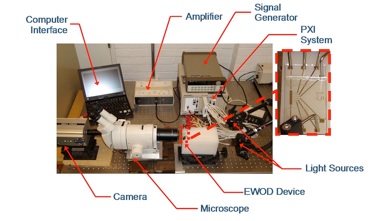
Figure-4. Equilibrium measurements set-up.
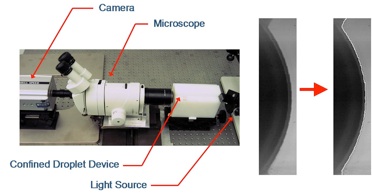
Figure-5. Dynamic measurements set-up.
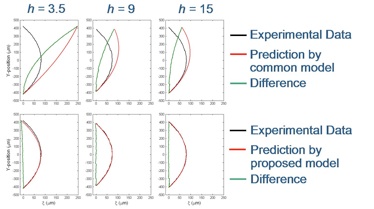
Figure-6. Validation of analytical models.
The ultimate goal of this research project is the development of EWOD devices that can perform practical biological protocols. One of the proposed advantages of microfluidic systems, and EWOD devices in particular, is the ability to increase throughput by automating protocols and running them in parallel. Monitoring EWOD devices is often performed manually, but this task must be automated for practical applications. Most systems for automated droplet control determine the presence of droplets in EWOD devices based on either optical observation or capacitance measurements. Droplet mixing is generally manually observed in these devices and an analytical model was derived in the MMDL showing that capacitance measurements could be used to determine the composition of droplets in EWOD devices [2]. This model was then verified experimentally (Figure-7). Experiments were then performed to show that capacitance measurements can be used to monitor droplet mixing in real time on EWOD devices (Figure-8).
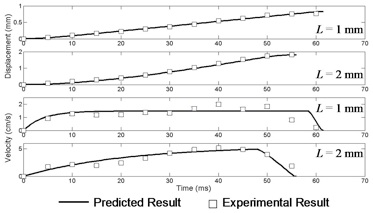
Figure-7. Validation of models to predict capillary force acting on a droplet.
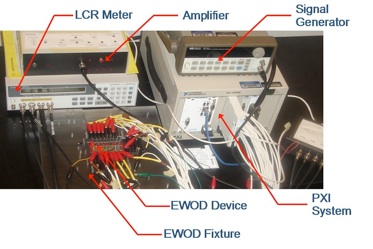
Figure-8. Experimental set-up to verify droplet mixing.
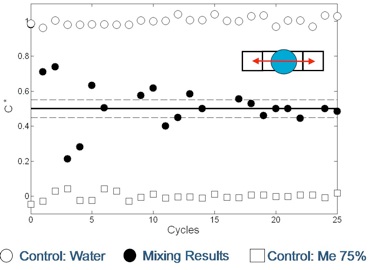
Figure-9. Experimental verification of droplet mixing.
The current project is focused on the development of EWOD devices that perform immunoassays. To that end, current investigations are focused on the manipulation of particles and automated monitoring of chemical reactions in EWOD devices.
Electrowetting on Dielectric Devices – List of Publications
Schertzer M.J., Gubarenko S.I., Ben Mrad R., Sullivan P.E. (Accepted Oct. 2010); An empirically validated analytical model of droplet dynamics in EWOD devices; Langmuir. (Manuscript ID: la-2010-03702t.R1)
Schertzer M.J., Ben Mrad R., Sullivan P.E. (2010); Using capacitance measurements in EWOD devices to identify fluid composition and control droplet mixing; Sensors & Actuators: B. Chemical.145; p 340-347
Schertzer M.J., Gubarenko S.I., Ben Mrad R., Sullivan P.E. (2010); An empirically validated model of the pressure within a droplet confined between plates at equilibrium for low bond numbers; Experiments in Fluids. 48; p 851-862
